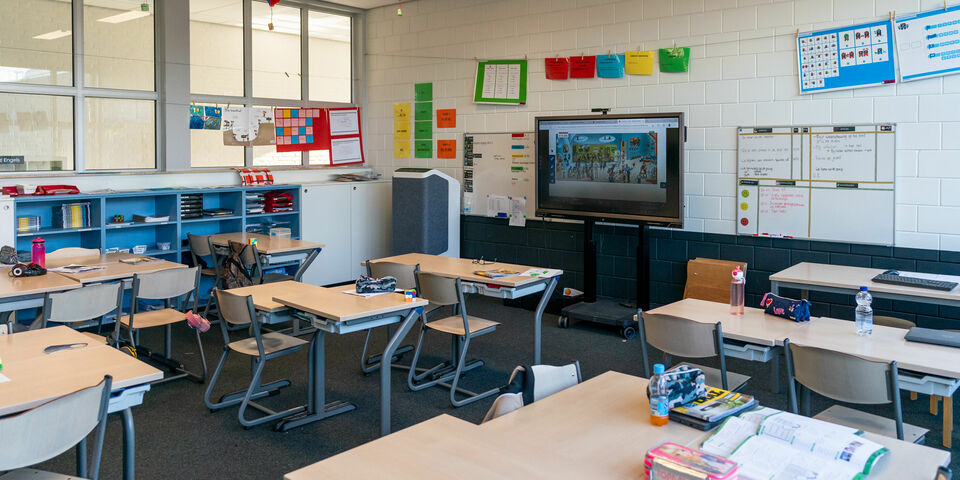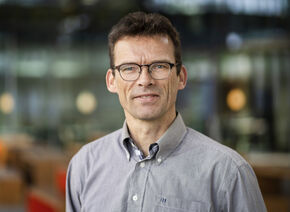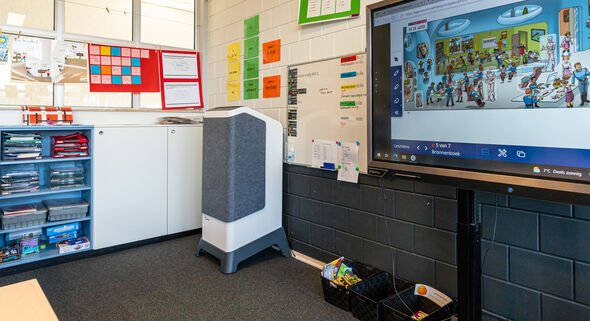Prof Talk | COVID in the classroom
Now that the number of COVID-19 infections in the Netherlands is on the rise again, educational institutions are taking various measures to avoid closures. Mandatory CO2 monitors, an ever-increasing demand for UV-C lamps. Are the effects of ventilation and air purification overestimated? Certainly not, ventilation expert professor Bert Blocken and lighting expert Luc Schlangen say. Both TU/e scientists call for proper research into the effects of these measures before any definitive statements are made. Meanwhile, their advice to schools is to by all means continue working on the improvement of air quality in classrooms.
A recent study carried out at Dutch high schools, cited in de Volkskrant last week, showed that COVID-19 spreads mainly between people who are in close contact with each other, and that CO2 monitors “aren’t the silver bullet” in these kinds of settings. At the same time, education minister Wiersma wants to make CO2 monitors in classrooms mandatory, so as to track ventilation levels.
Bert Blocken, professor of Building Physics, read the newspaper article about the study from Utrecht with much consternation. For the past two and a half years now, he has been stressing the importance of ventilation and air purification to reduce the spread of COVID-19. “This study has already been greeted with much criticism online. Technically speaking, the experiments were carried out in a rather unfortunate manner, to put it mildly, but the researchers nevertheless draw some serious conclusions. Transmission via aerosols seems unimportant, they say, but at the same time, they admit that there are limitations to their study. It’s just wrong that a newspaper decided to publish this.”
Capture viruses
Blocken uses a sketch of the study setting to explain its most important limitations. “The air was already being properly ventilated when the researchers took samples of the virus. Exhaled air immediately disappears to the outside environment via the stream of the ventilator and doesn’t mix with the air that is present in the room. It’s no surprise that the virus can’t be detected in the devices on the ceiling designed to capture viruses. We inhale and exhale through our nose and mouth, which is why you should place those devices at head level. As far as I know, they still don’t stick children to the ceiling in schools,” he adds with a wink.
He also fails to understand why the researchers measured CO2 concentration only twice, instead of for a longer period of time. “It’s unfortunate that a group of epidemiologists, virologists and microbiologists worked on a ventilation-orientated study. A typical case of ‘stuck to what you know.’ Because if you want to draw conclusions about the usefulness of ventilation, you also need to measure every essential parameter: how large is the classroom, how large are the doors and windows, what is the speed and direction of the wind?”
Several international studies have shown, Blocken says, that proper ventilation does indeed help limit transmission of the SARS-CoV-2 virus, as was eventually acknowledged by the WHO at a later stage of the pandemic. Moreover, it reduces the number of infectious virus particles in a room even more effectively when combined with air purification, Luc Schlangen adds. Schlangen is division director of Photobiology and Photochemistry at the International Commission on Illumination and is surrounded by experts in the field of UV-C. “Ultraviolet radiation with a wavelength of around 250 nm is highly effective at deactivating the genetic material of pathogens such as viruses and bacteria. When you mount UV-C lamps high up on a ceiling, you can create what is known as continuous upper room air disinfection. This renders the viral particles circulating in the air close to the lamps harmless. And when these lamps are installed by experts, they won’t pose any health hazards because of the large distance; your skin and eyes are hardly exposed to these lamps.”
Energy prices
The UV-C lamps produced by Signify (formerly Philips Lighting) claim to inactivate viruses in a period of 10 minutes equal to 50 air changes per hour. To clarify: scientists advise 6 to 9 air rates per hour in order to mitigate the risk of getting infected with a pathogen from inhalation. Blocken: “In situations where there’s highly adequate ventilation, or where air is distributed with so-called displacement ventilation, you need to ask yourself just how many virus particles are present in the air close to the ceiling. However, when the windows aren’t opened that often, which could lead to a mixed air flow, upper room disinfection with UV-C lamps could be of great use. And in view of the current energy prices, you don’t want the doors and windows of classrooms to be open all the time.”
If we want to devise an effective prevention program, it’s essential that we first gain a proper understanding of the transmission route of SARS-CoV-2 and of the level of infection risks, Schlangen believes. “There’s a lot we still don’t know. It will require more in-depth research.” And that’s exactly what Blocken tries to realize with a recently launched study at more than one hundred elementary schools in the Netherlands and Belgium, he explains. “We have a combination of experts in virology and engineers, which is a good place to start from. We compare control classrooms with nothing but ventilation, and classrooms with ventilation combined with air purification and check for the presence of active coronaviruses. We take several parameters into account – open window, tilted position, or mechanical ventilation – as well as several air disinfection techniques. A large study, with many, many samples.”
Junk
Blocken expects that the first results of this ventilation study will arrive in a few months. Until that time, both he and Schlangen are in favor of every possible effort to reduce coronaviruses in classrooms. Blocken: “Seven hundred classrooms in Eindhoven will be fitted with UV-C lamps, and the ministry of health and education is about to launch a major air purification pilot in collaboration with us. In addition, schools are increasingly willing to invest in air purification and ventilation themselves. It’s important, however, that the air purifiers have sufficient power and that they are of a high-quality design. There’s a lot of junk on the market too, unfortunately, and that’s true for CO2 monitors as well. I even came across one recently that indicated even less CO2 indoors than the normal atmospheric CO2 level. I’ve been giving free advice to schools for one and a half years now, and I once again call upon school directors to approach me whenever they have a question or are in doubt.”





Discussion